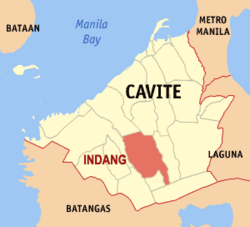Indang
| Municipality of Indang | ||
| Location of Indang in the province of Cavite | ||
|---|---|---|

|
||
| Basic data | ||
| Region : | CALABARZON | |
| Province : | Cavite | |
| Barangays : | 36 | |
| District: | 3. District of Cavite | |
| PSGC : | 042110000 | |
| Income class : | 3rd income bracket | |
| Households : | 10,608 May 1, 2000 census
|
|
| Population : | 65,599 August 1, 2015 census
|
|
| Population density : | 625.3 inhabitants per km² | |
| Area : | 104.90 km² | |
| Coordinates : | 14 ° 12 ' N , 120 ° 53' E | |
| Postal code : | 4122 | |
| Area code : | +63 46 | |
| Mayor : | Bienvenido Dimero | |
| Geographical location in the Philippines | ||
|
|
||
Indang is a municipality in the Philippines in Cavite Province .
In the past, a British Village and a British school were established in Indang .
history
Indang (originally: Indan ) became an independent municipality in 1655 after the place had previously belonged to Silang . The name Indan is derived from the Tagalog word indang or inrang for a species of tree that was found in this area.
Andrés Bonifacio was captured in Baranggay Limbon after the Tejeros Convention was defeated during the Philippine Revolution . Thus he was prevented from pursuing his counter-revolutionary plans to build up a government and army.
Cavite State University
The main campus of Cavite State University (formerly Don Severino Agricultural College ) is in Indang.
mayor
Mayor of Indangs from 2004 to 2007 was Lope Tepora. Mayor since 2007 is Bienvenido Dimero.
Barangays
Indang is politically divided into 36 barangays .
|
|
|
